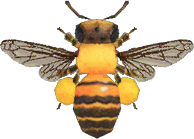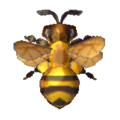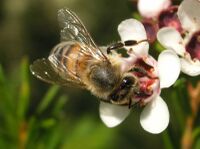Difference between revisions of "Honeybee"
AlexBot2004 (talk | contribs) |
Bowserbros (talk | contribs) |
||
| (38 intermediate revisions by 12 users not shown) | |||
| Line 1: | Line 1: | ||
{{Bug Header}} | {{Bug Header}} | ||
| − | {{ | + | {{Wrongpage|the harmless variety found near flowers|the larger and stinging variety found in trees|wasp}} |
| − | |||
{{Infobox Bug | {{Infobox Bug | ||
| − | |name= | + | |name = honeybee |
| − | |ja-name= ミツバチ | + | |ja-name = ミツバチ |
| − | |ko-name= 꿀벌 | + | |ko-name = 꿀벌 |
| − | |zh-name= 蜜蜂 | + | |zh-name = 蜜蜂 |
| − | |fr-name= Abeille naine | + | |fr-name = Abeille naine |
| − | |it-name= Ape operaia | + | |it-name = Ape operaia |
| − | |es-name= Abeja melífera | + | |es-name = Abeja melífera |
| − | |de-name= Honigbiene | + | |de-name = Honigbiene |
| − | |nl-name= Honingbij | + | |nl-name = Honingbij |
| − | |ru-name= Восковая пчела | + | |ru-name = Восковая пчела |
| − | |image= Honeybee NH.png | + | |image = Honeybee NH.png |
| − | |scientific name= Apis mellifera | + | |icon = Honeybee NH Icon.png |
| − | |family= Apidae- Various Bees | + | |scientific name = Apis mellifera |
| − | + | |family = Apidae- Various Bees | |
| − | |||
| − | |||
| − | |||
| − | |||
| − | |||
}} | }} | ||
| − | The ''' | + | The '''honeybee''' is a [[bug]] in the {{SER}}. It first appeared in {{WW}} and has appeared in all subsequent games. It can be found flying near flowers. In {{NH}}, it can be caught from [[spring]] to the start of [[summer]]. |
| − | |||
__TOC__ | __TOC__ | ||
==Catch details== | ==Catch details== | ||
| + | ===In {{WW|short|nolink}}=== | ||
| + | {{WWBugInfo | ||
| + | |name = honeybee | ||
| + | |number= 11 | ||
| + | |image = Honeybee WW Icon.png | ||
| + | |catchphrase= | ||
| + | |description= The worker bees are female. Honey is a natural preservative! | ||
| + | |availability= Mar – Sep | ||
| + | |times= 9 AM – 4 PM | ||
| + | |times-peak= Mar – Jul | ||
| + | |location= Flying near flowers | ||
| + | |bug-size= 13 mm | ||
| + | |rarity= Common | ||
| + | |sell= 100 | ||
| + | |pal-sell= 90 | ||
| + | |tank-width= 1.0 | ||
| + | |tank-length= 1.0 | ||
| + | }} | ||
| + | |||
===In {{CF|short|nolink}}=== | ===In {{CF|short|nolink}}=== | ||
{{CFBugInfo | {{CFBugInfo | ||
| + | |name = honeybee | ||
|number = 12 | |number = 12 | ||
|image = Honeybee CF Icon.png | |image = Honeybee CF Icon.png | ||
| Line 35: | Line 48: | ||
|description = All worker bees are female. Their honey has an almost indefinite shelf life. | |description = All worker bees are female. Their honey has an almost indefinite shelf life. | ||
|availability=Mar – Jul | |availability=Mar – Jul | ||
| − | |times = 8 AM | + | |times = 8 AM – 5 PM |
|time-availability =Mar – Jun | |time-availability =Mar – Jun | ||
|time2 = 8 AM – 4 PM | |time2 = 8 AM – 4 PM | ||
| Line 55: | Line 68: | ||
===In {{NL|short|nolink}}=== | ===In {{NL|short|nolink}}=== | ||
{{NLBugInfo | {{NLBugInfo | ||
| + | | name = honeybee | ||
| number = 12 | | number = 12 | ||
| image = Honeybee NL Icon.png | | image = Honeybee NL Icon.png | ||
| catchphrase = I caught a honeybee! What a sweet catch! | | catchphrase = I caught a honeybee! What a sweet catch! | ||
| − | | availability = Mar | + | | availability = Mar – Jul |
| − | | times = 8 AM | + | | times = 8 AM – 5 PM |
| − | | time-availability = Mar | + | | time-availability = Mar – Jun |
| − | | time2 = 8 AM | + | | time2 = 8 AM – 4 PM |
| time2-availability = Jul | | time2-availability = Jul | ||
| − | |m3 = Yes | + | | m3 = Yes |
| − | |m4 = Yes | + | | m4 = Yes |
| − | |m5 = Yes | + | | m5 = Yes |
| − | |m6 = Yes | + | | m6 = Yes |
| − | |m7 = Yes | + | | m7 = Yes |
| location = Flying near flowers | | location = Flying near flowers | ||
| size = 16 mm | | size = 16 mm | ||
| Line 78: | Line 92: | ||
===In {{NH|short|nolink}}=== | ===In {{NH|short|nolink}}=== | ||
{{NHBugInfo | {{NHBugInfo | ||
| − | | name = | + | | name = honeybee |
| number = 24 | | number = 24 | ||
| image = Honeybee NH Icon.png | | image = Honeybee NH Icon.png | ||
| + | | render = Honeybee NH.png | ||
| catchphrase = I caught a honeybee! Ah, sweet success! | | catchphrase = I caught a honeybee! Ah, sweet success! | ||
| n-availability = Mar – Jul | | n-availability = Mar – Jul | ||
| Line 108: | Line 123: | ||
==Donating to the museum== | ==Donating to the museum== | ||
| − | |||
| − | |||
===In {{WW|short|nolink}}=== | ===In {{WW|short|nolink}}=== | ||
| − | + | {{Blathers|WW|The stinger of a honeybee is actually connected to its internal organs, eh wot? When it {{wp|Honey bee#Defense|uses its stinger}}... the organs get pulled out. What an abhorrent image! I'm terribly sorry, but nature is not always family friendly!}} | |
| − | |||
| − | |||
| − | The | + | The honeybee can be found at the middle-left side of the first room of the [[bug]]s section, on the flowers. |
===In {{CF|short|nolink}}=== | ===In {{CF|short|nolink}}=== | ||
| − | + | {{Blathers|CF|Honeybees are rather famous among bees for the impressive teamwork they exhibit, eh wot? I've even heard they will swarm over enemies many times their size in an attempt to suffocate them. I must admit, it makes them seem rather like a bunch of brave warriors... Even so, when I imagine a massive swarm of bees, a different phrase comes to mind... "BLEEECCCH!}} | |
| − | |||
| − | |||
| − | It can be found in the lower-left section of the exhibit, buzzing the roses. | + | It can be found in the lower-left section of the exhibit, buzzing among the roses. |
===In {{NL|short|nolink}}=== | ===In {{NL|short|nolink}}=== | ||
| − | Upon being donated, the | + | Upon being donated, the honeybee can be found in the first room of the bug exhibit flying around and resting on the bushes near the back of the room. The exhibit has this to say about the honeybee: |
| − | + | {{Blathers|NL|Honeybees gather nectar from flowers and make honey, making them integral in many ecosystems. The worker bees are females and the only ones capable of stinging, though that is rather rare. The hive does contain males, but after mating season, they are all sent away. Honey has been consumed since ancient times. Cave paintings 8,000 years old show people eating honey.}} | |
| − | |||
===In {{NH|short|nolink}}=== | ===In {{NH|short|nolink}}=== | ||
| − | + | {{Blathers|CNH|Did you know it takes a team of honeybees working together to transform flower nectar into honey? Indeed, forager bees suck nectar from flowers into their "honey stomachs" and then fly it to the hive. Hive bees then chew the substance and spit it into the honeycomb, fluttering their wings to dry it out. Yes, you could say honey is a tasty tribute to the hard work of the humble honeybee. Oh! Oh my! You mustn't confuse my lengthy description for admiration! At the end of the day, honeybees are still insects, and thus still ghastly! A wee bit ghastly than most, I admit.}} | |
| − | |||
| − | |||
| − | + | The honeybee can be found on the tropical flower bed near the [[man-faced stink bug]] and the [[mantis]]. | |
| − | |||
| − | == | + | ==Gallery== |
| − | {{ | + | {{Gallery||Sprites and encyclopedia images}} |
| − | | | ||
| − | | | ||
| − | |||
| − | |||
| − | }} | ||
==Real-world information== | ==Real-world information== | ||
| − | [[File:Honeybee.jpg|left|200px|thumb|A European | + | [[File:Honeybee.jpg|left|200px|thumb|A European honeybee settling on a flower.]] |
| − | ''Apis mellifera'', the European honeybee, is a species of honeybee that is used frequently around the world to produce honey. There are many subspecies of this bee due to human intervention. | + | ''Apis mellifera'', the European honeybee, is a species of honeybee which that is used frequently around the world to produce honey; contrary to its name, the species originated from Africa rather than Europe. There are many subspecies of this bee due to human intervention. Like the in-game [[wasp]] and most species of bee, the European honeybee is capable of delivering a venomous sting, though this does not occur in-game. Unlike these other species, the European honeybee's stinger is barbed, causing the bee to fatally disembowel itself when the stinger is caught in the target's skin, leaving behind a sac that continues to envenomate the target until the stinger is removed. Despite being omnivorous, the European honeybee preys on microbes rather than other insects; consequently, stinging is used exclusively to protect against perceived threats. |
The European honeybee has been subject to Colony Collapse Disorder (CCD), an unexplained phenomenon in which all worker bees leave their colony and die, leaving the hive without any means of supporting itself. | The European honeybee has been subject to Colony Collapse Disorder (CCD), an unexplained phenomenon in which all worker bees leave their colony and die, leaving the hive without any means of supporting itself. | ||
| − | + | {{Clear}} | |
| − | {{ | ||
==Names in other languages== | ==Names in other languages== | ||
{{Foreignname | {{Foreignname | ||
| − | |ja= ミツバチ | + | |ja=ミツバチ |
| − | |ja-r= | + | |ja-r=Mitsubachi |
| − | |ja-m= Honeybee | + | |ja-m=Honeybee |
| − | |es= Abeja melífera | + | |es=Abeja melífera |
| − | |es-m= Honeybee | + | |es-m=Honeybee |
| − | |fr= Abeille naine | + | |fr=Abeille naine |
| − | |fr-m= Dwarf bee | + | |fr-m=Dwarf bee |
| − | |nl= Honingbij | + | |nl=Honingbij |
| − | |nl-m= Honeybee | + | |nl-m=Honeybee |
| − | |de= Honigbiene | + | |de=Honigbiene |
| − | |de-m= Honeybee | + | |de-m=Honeybee |
| − | |it= Ape operaia | + | |it=Ape operaia |
| − | |it-m= Literally worker bee, honeybee | + | |it-m=Literally worker bee, honeybee |
| − | |ko= 꿀벌 | + | |ko=꿀벌 |
| − | |ko-r= | + | |ko-r=Kkulbeol |
| − | |ko-m= Honeybee | + | |ko-m=Honeybee |
| − | |zh= 蜜蜂 | + | |zh=蜜蜂 |
| − | |zh-r= | + | |zh-r=Mìfēng |
| − | |zh-m= Honeybee | + | |zh-m=Honeybee |
| − | |ru= Восковая пчела | + | |ru=Восковая пчела |
| − | |ru-r= Voskovaya pchela | + | |ru-r=Voskovaya pchela |
| − | |ru-m= Asiatic honeybee | + | |ru-m=Asiatic honeybee |
}} | }} | ||
| − | {{ | + | ==Notes== |
| + | {{Note list}} | ||
| + | {{Navbox Bugs}} | ||
[[Category:Wild World bugs]] | [[Category:Wild World bugs]] | ||
[[Category:City Folk bugs]] | [[Category:City Folk bugs]] | ||
[[Category:New Leaf bugs]] | [[Category:New Leaf bugs]] | ||
| + | [[Category:Happy Home Designer bugs]] | ||
[[Category:New Horizons bugs]] | [[Category:New Horizons bugs]] | ||
| + | |||
| + | [[es:Abeja Melífera]] | ||
Revision as of 22:50, March 18, 2024
The honeybee is a bug in the Animal Crossing series. It first appeared in Animal Crossing: Wild World and has appeared in all subsequent games. It can be found flying near flowers. In Animal Crossing: New Horizons, it can be caught from spring to the start of summer.
Catch details
In Wild World
| Description | The worker bees are female. Honey is a natural preservative! |
|---|---|
| Time of year | Mar – Sep |
| Time of day | 9 AM – 4 PM |
| Peak times | Mar – Jul |
| Location | Flying near flowers |
| Bug size | 13 mm |
| Rarity | Common |
| Selling price | |
| Furniture size |
In City Folk
| Description | All worker bees are female. Their honey has an almost indefinite shelf life. |
|---|---|
| Time of year | Mar – Jul |
| Time of day | Mar – Jun: 8 AM – 5 PM Jul: 8 AM – 4 PM |
| Peak times | N/A |
| Location | Flying near flowers |
| Bug size | 13 mm |
| Rarity | Uncommon |
| Selling price | |
| Furniture size |
In New Leaf
| Time of year | Mar – Jul |
|---|---|
| Time of day | Mar – Jun: 8 AM – 5 PM Jul: 8 AM – 4 PM |
| Peak times | N/A |
| Location | Flying near flowers |
| Size | 16 mm |
| Rarity | Common |
| Selling price | |
| Furniture size |
In New Horizons
| Time of year | North: Mar – Jul South: Sep – Jan |
|---|---|
| Time of day | 8 AM – 5 PM |
| Location | Flying near flowers |
| Weather | Any except rain |
| Spawn requirement | Appears from the start of the game |
| Selling prices | |
| Furniture size |
Donating to the museum
In Wild World
The honeybee can be found at the middle-left side of the first room of the bugs section, on the flowers.
In City Folk
It can be found in the lower-left section of the exhibit, buzzing among the roses.
In New Leaf
Upon being donated, the honeybee can be found in the first room of the bug exhibit flying around and resting on the bushes near the back of the room. The exhibit has this to say about the honeybee:
In New Horizons
The honeybee can be found on the tropical flower bed near the man-faced stink bug and the mantis.
Gallery
Real-world information
Apis mellifera, the European honeybee, is a species of honeybee which that is used frequently around the world to produce honey; contrary to its name, the species originated from Africa rather than Europe. There are many subspecies of this bee due to human intervention. Like the in-game wasp and most species of bee, the European honeybee is capable of delivering a venomous sting, though this does not occur in-game. Unlike these other species, the European honeybee's stinger is barbed, causing the bee to fatally disembowel itself when the stinger is caught in the target's skin, leaving behind a sac that continues to envenomate the target until the stinger is removed. Despite being omnivorous, the European honeybee preys on microbes rather than other insects; consequently, stinging is used exclusively to protect against perceived threats.
The European honeybee has been subject to Colony Collapse Disorder (CCD), an unexplained phenomenon in which all worker bees leave their colony and die, leaving the hive without any means of supporting itself.
Names in other languages
| ミツバチ Mitsubachi |
Honeybee | |
| 꿀벌 Kkulbeol |
Honeybee | |
| 蜜蜂 Mìfēng |
Honeybee | |
| Восковая пчела Voskovaya pchela |
Asiatic honeybee | |
| Honingbij | Honeybee | |
| Honigbiene | Honeybee | |
| Abeja melífera | Honeybee | |
| Abeille naine | Dwarf bee | |
| Ape operaia | Literally worker bee, honeybee | |
Notes
| Bugs | |||||||||||||||||||
|---|---|---|---|---|---|---|---|---|---|---|---|---|---|---|---|---|---|---|---|
| |||||||||||||||||||








